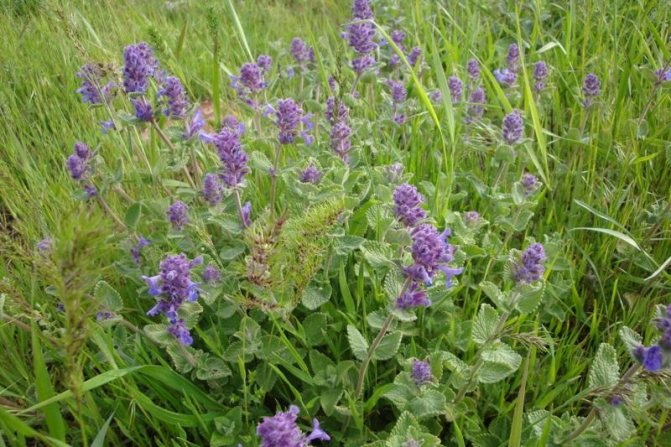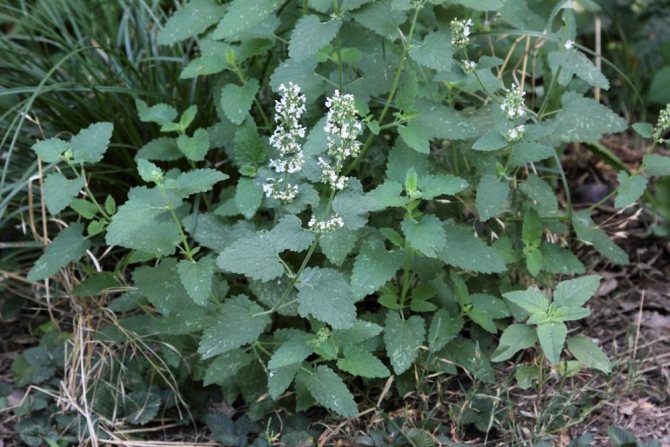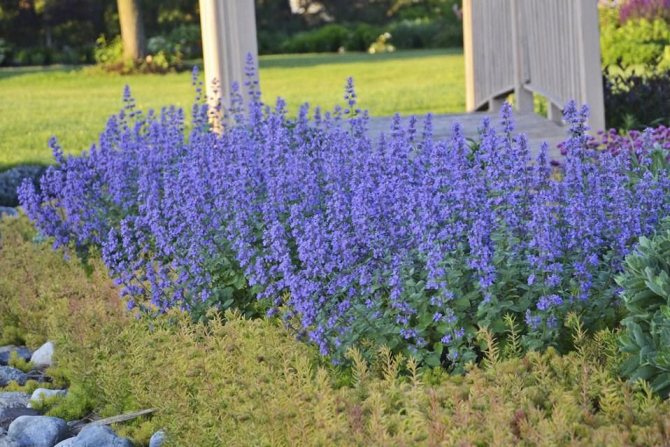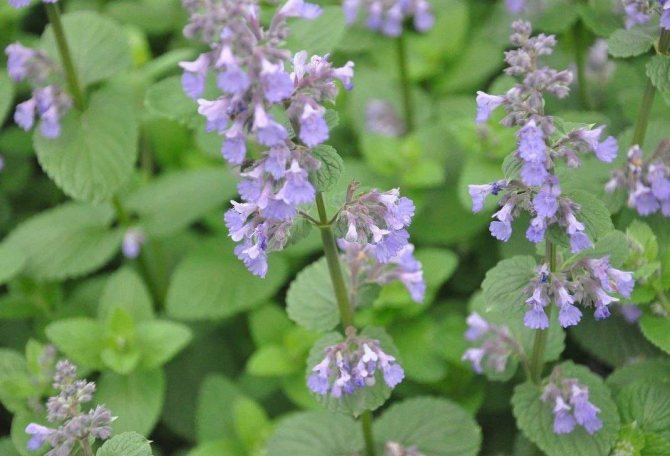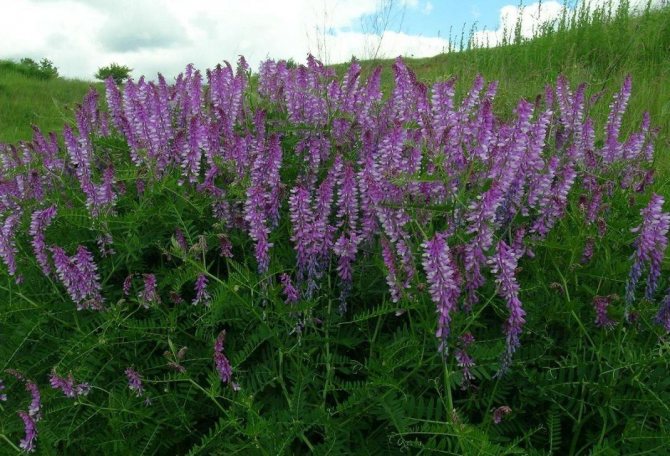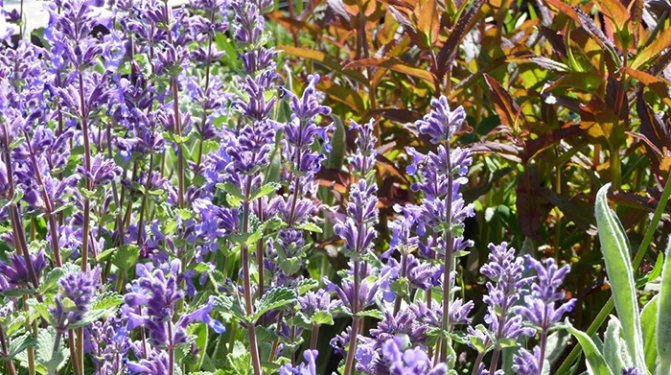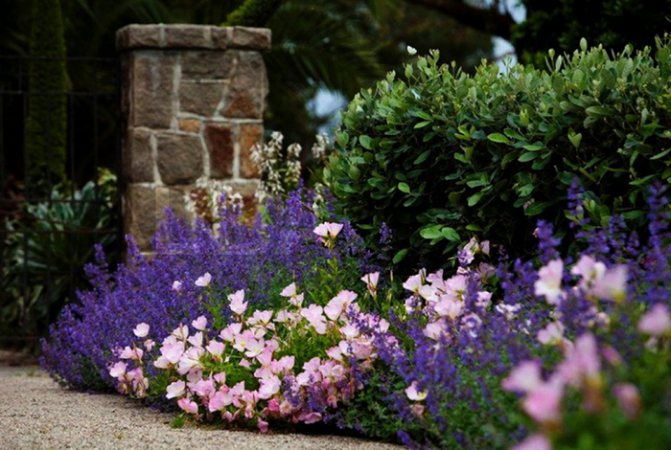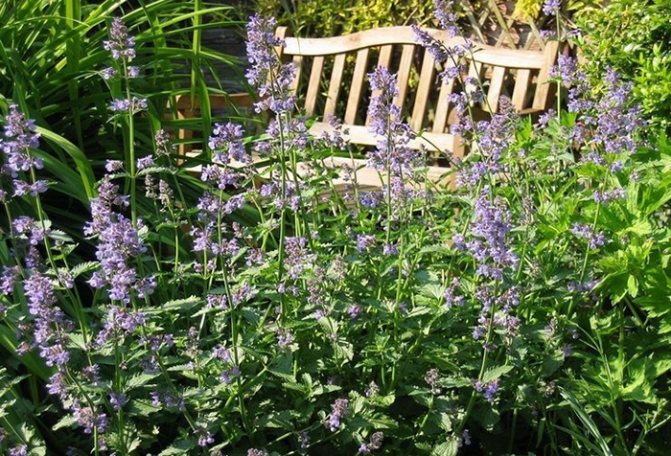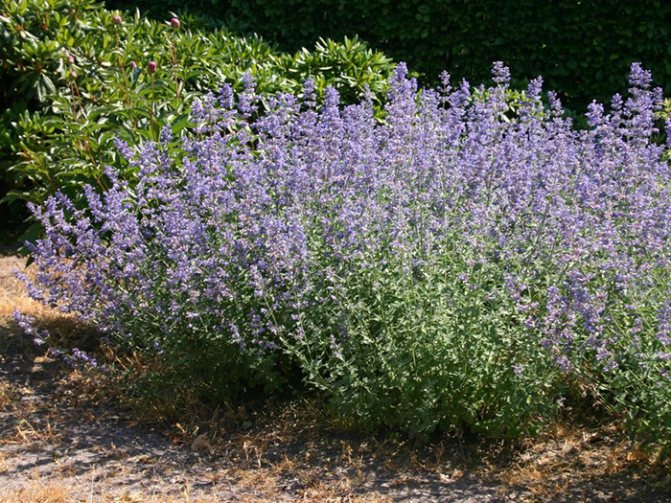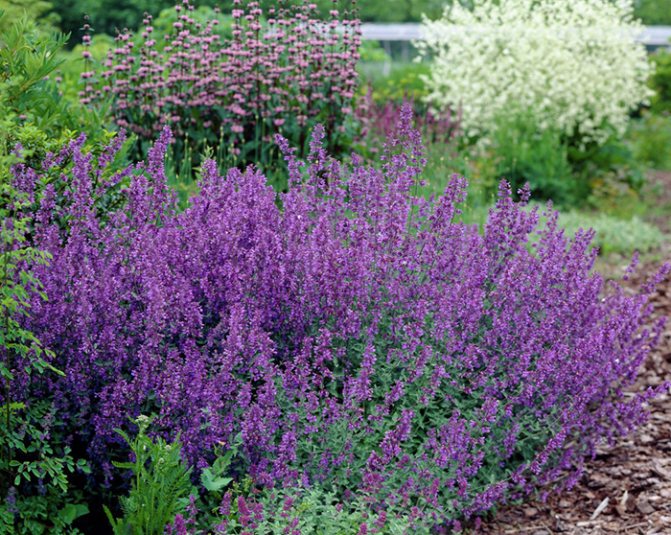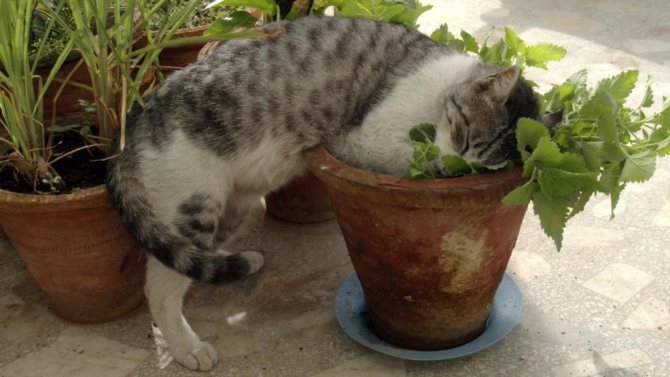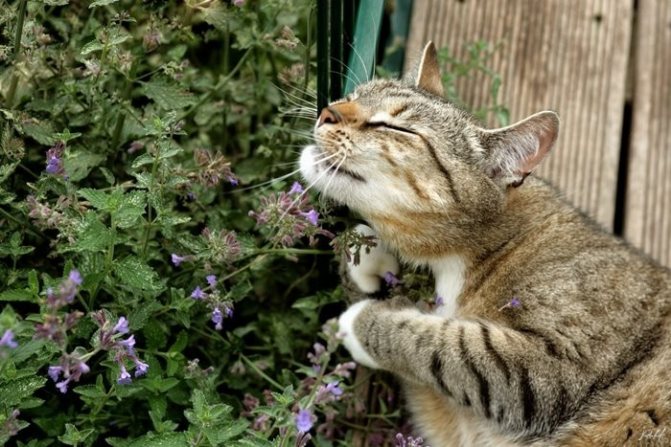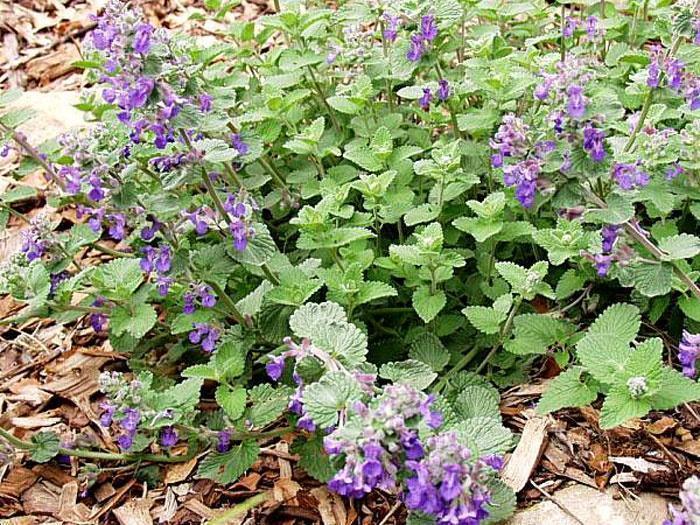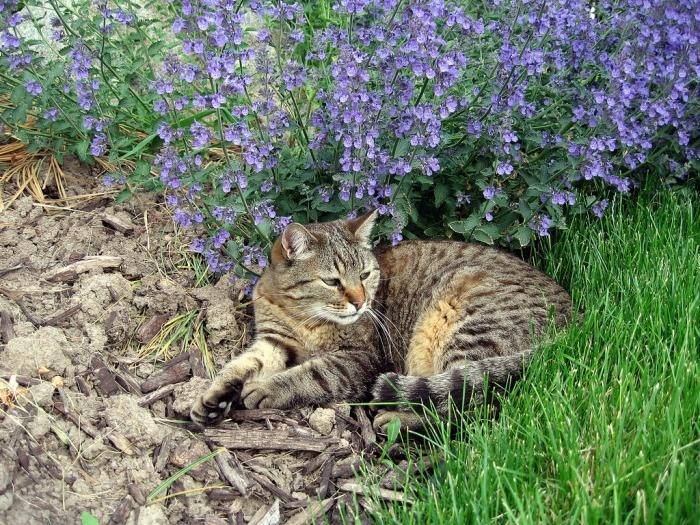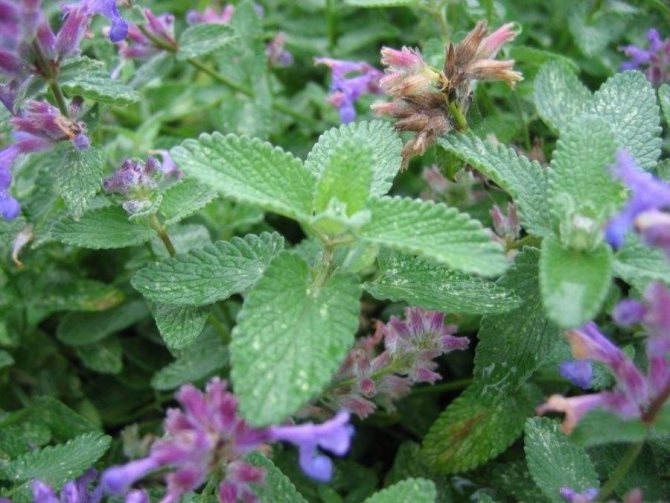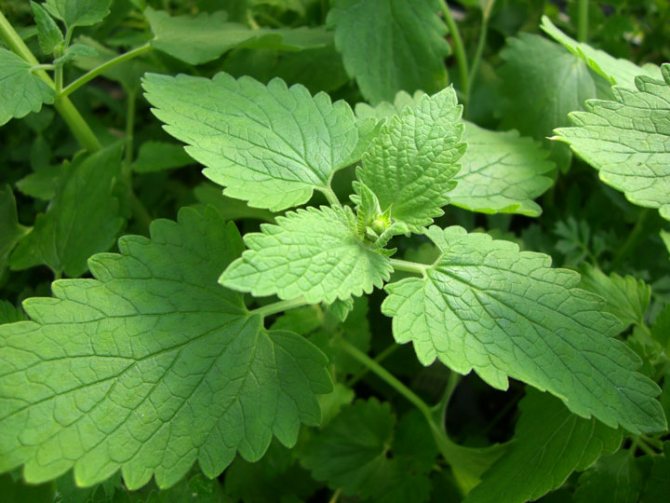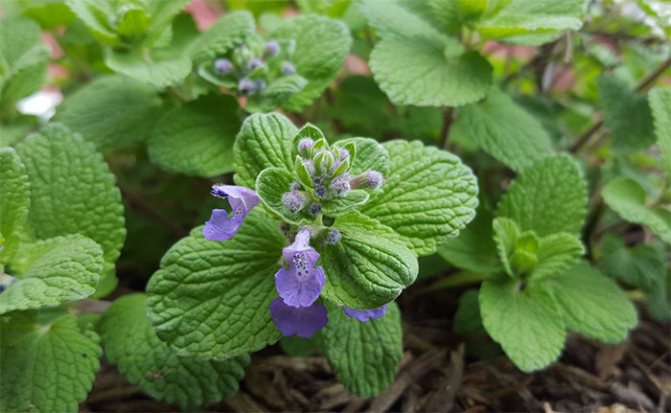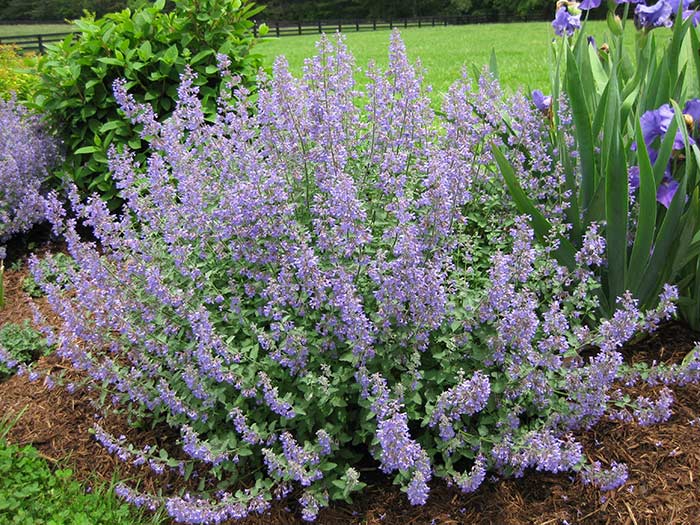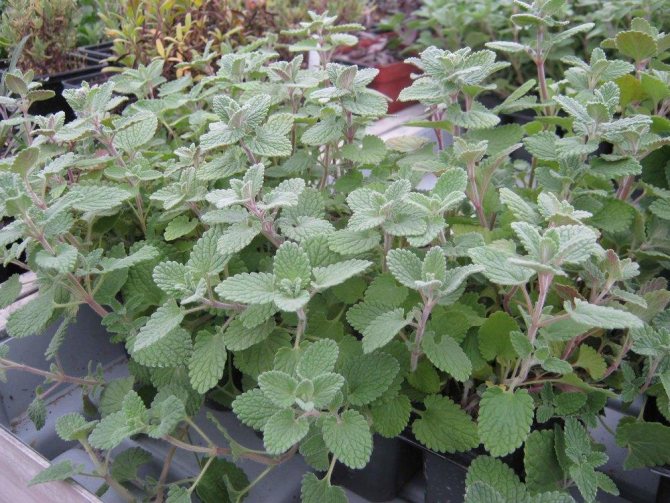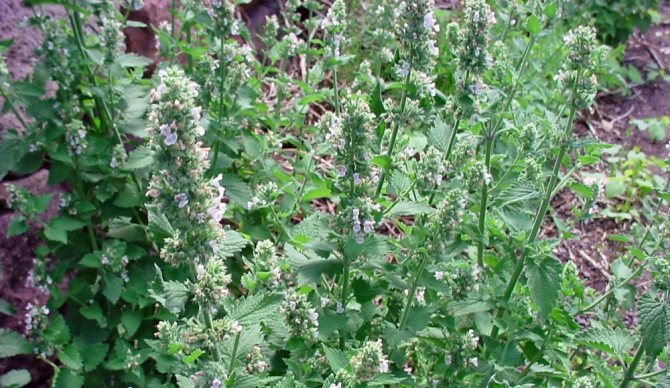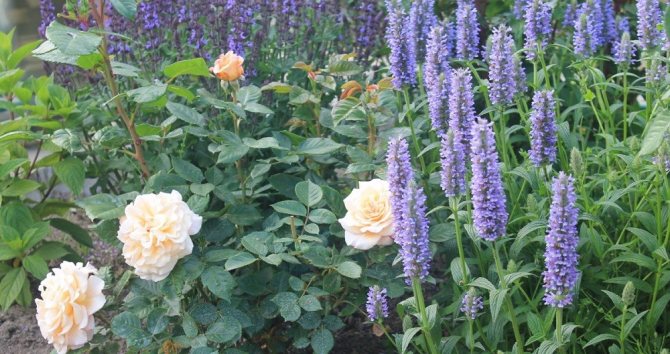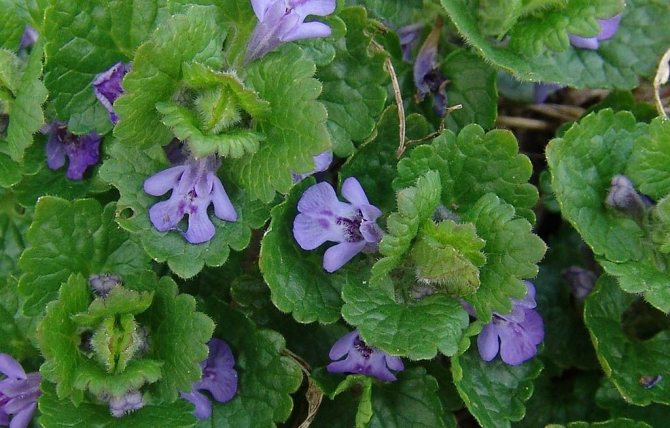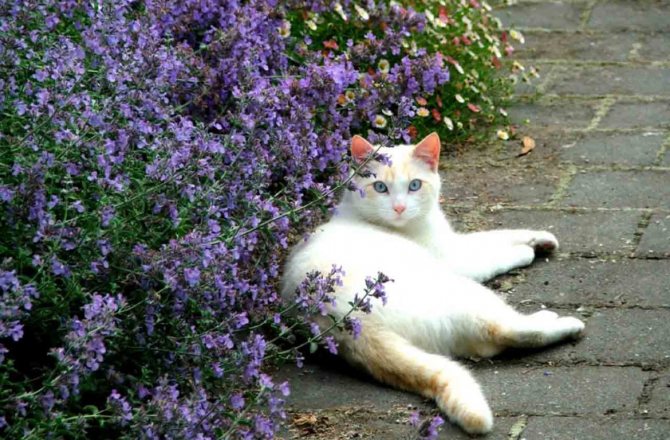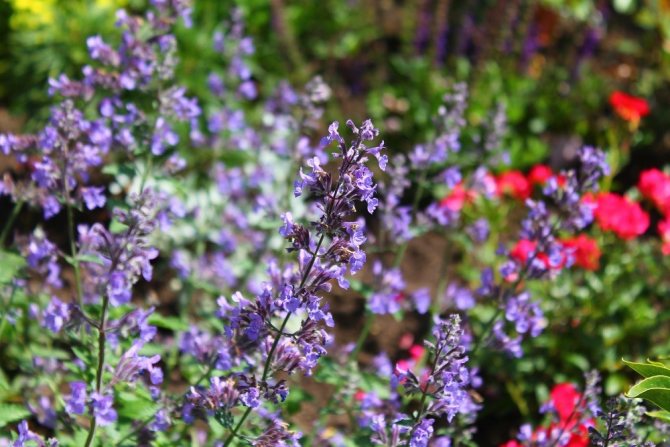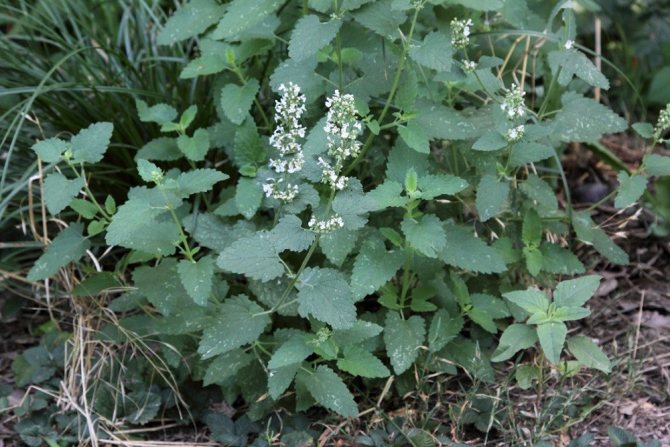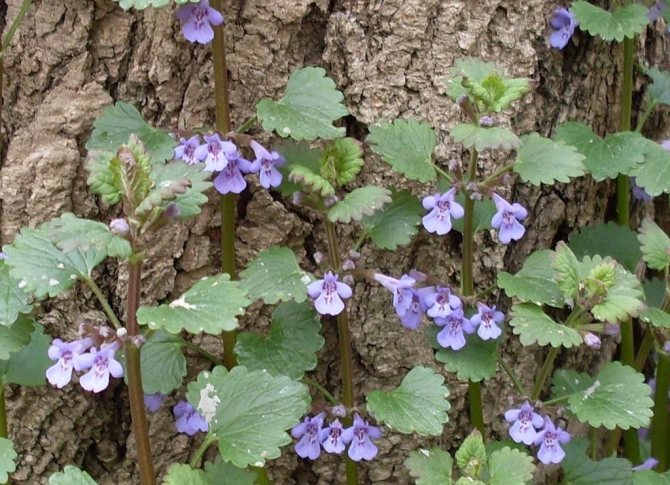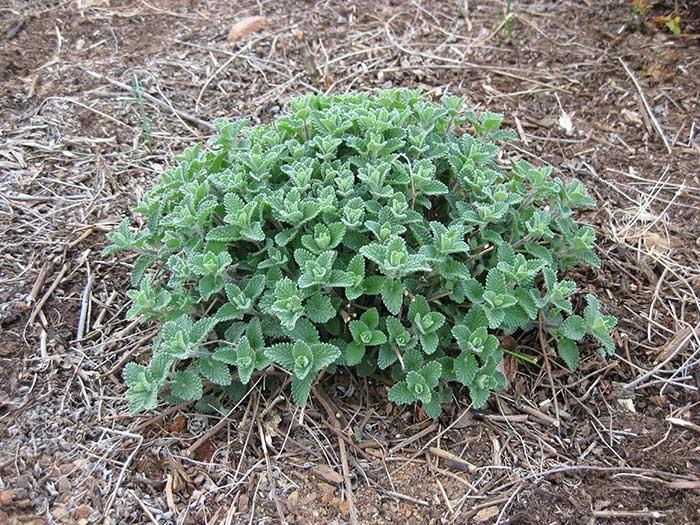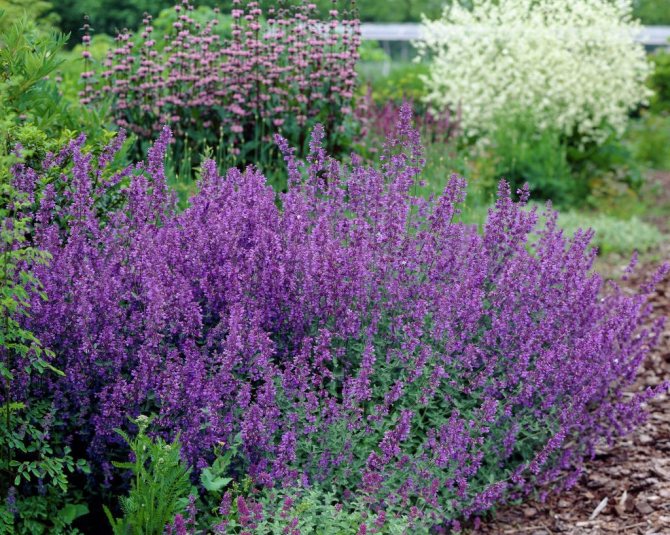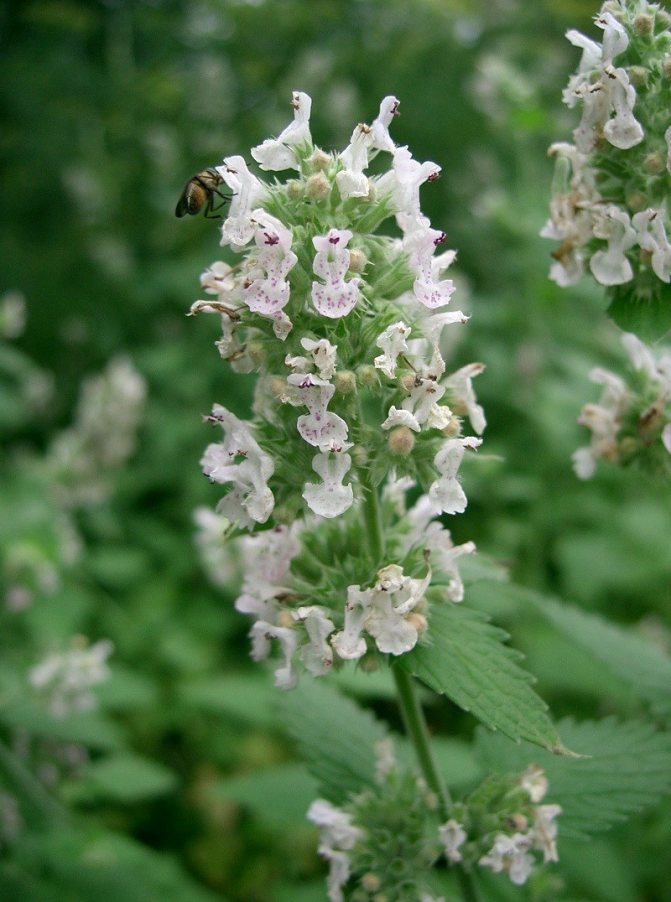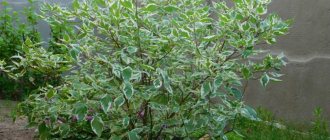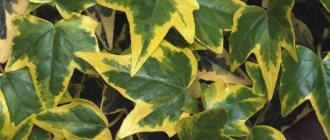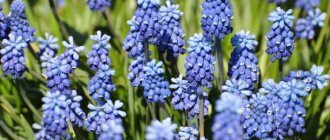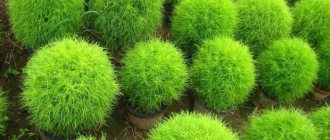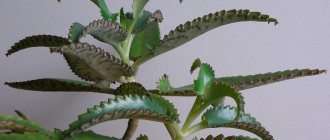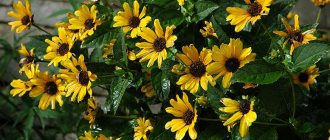Catnip is a well-known bait for our four-legged furry pets. Due to the presence of essential oils, the smell of which attracts cats so much - animals just go crazy with it. However, it has other characteristics that make it attractive to grow at home and in your gardens. The catnip bush is very decorative and easy to care for and also very durable. The Nepeta cataria plant or Catnip (Lemon and Fassena) can be cultivated as a shrub in the garden or indoors for decorative purposes. You can find out how the planting of the shrub is carried out and the follow-up care for it is organized in this article. We also offer you to see numerous photos of lemon catnip, Fassen and catnip:
Botanical description
Fassen's catnip is a perennial plant of the Labiate family, which appeared by a successful crossing of Mussini and Neptella's catnipes.
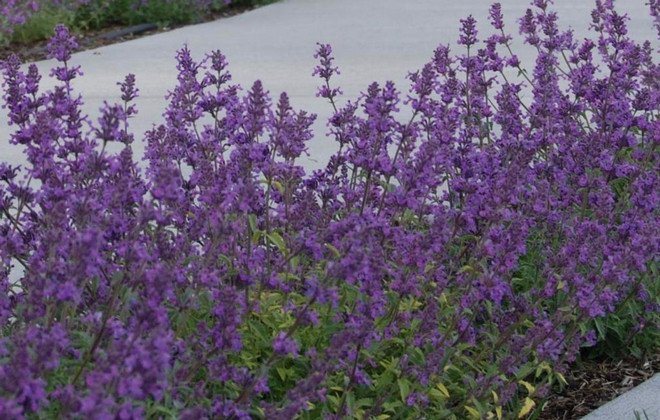
- Height: 20-60 cm.
- Rhizome: branched.
- Stems: upright.
- Leaves: oval heart-shaped with pointed edges, from green to gray-green.
- Color: blue, light blue, lavender, lilac.
- Inflorescences: long, strewn with flowers.
- Flowering period: June to September, can bloom twice a year.
- Fruit: boxes with seeds.
Plants such as plectranthus, physostegia, savory and thyme, lamb, ivy budra, clary sage, monarda, coleus are also included in the Lipo family.
The plant has a pleasant, pungent aroma similar to mint. Has a peculiar spicy bitter taste. Fassen's cattle is highly frost-resistant, photophilous, and prefers moist soil.
The grass grows in meadows and forest clearings, often found along roads and on rocky slopes.
Did you know? In ancient times, the catnip was considered a magical plant - it was used to summon otherworldly forces, in love spells.
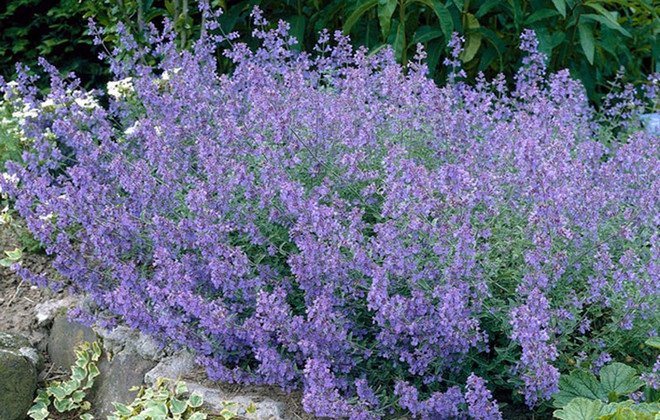

Catnip - photo
Today on the Internet you can find a large number of reviews about the catnip, judging by which it is safe to say that this plant is an excellent solution for creating unique garden compositions. Due to its unpretentiousness and sophisticated beauty, catnip has won the love and recognition of gardeners and designers, who include this plant in their garden masterpieces.
Varieties
The most popular are three varieties of Fassen's catnip:
- Six Hills Giant;
- Blue Wonder;
- Walkers Low.
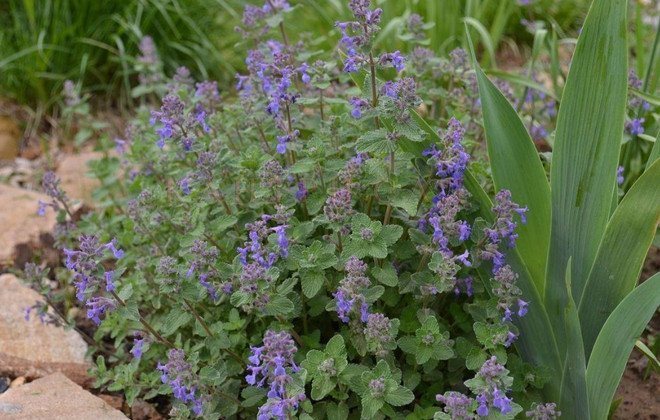

Six Hills Giant
Six Hills Giant - a perennial ornamental plant up to 50 cm in height. Sprawling bush with bright green leaves. Differs in rich blue-violet inflorescences. The flowering period is quite long - from late spring to early September.
The plant has a pleasant lemon-mint aroma. Prefers light fertile soil, grows well in a sunny and warm place. Drought-resistant, growing rapidly. In flower beds, it is combined with roses and other large perennials.
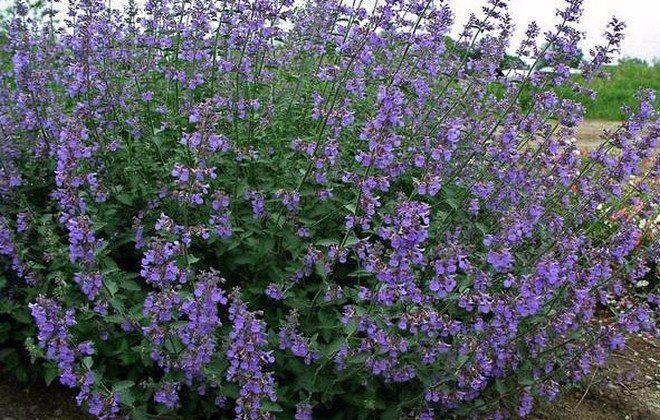

"Blue Wonder"
"Blue Wonder" - a dwarf fragrant plant up to 20 cm in height. The bush is dense and fluffy with spike-shaped sky-blue flowers. The herb blooms from June to September. It grows quickly and does not need special care.
A distinctive feature of this variety - low bushes with a bright azure hue create the effect of a "blue river" along the paths or alleys.
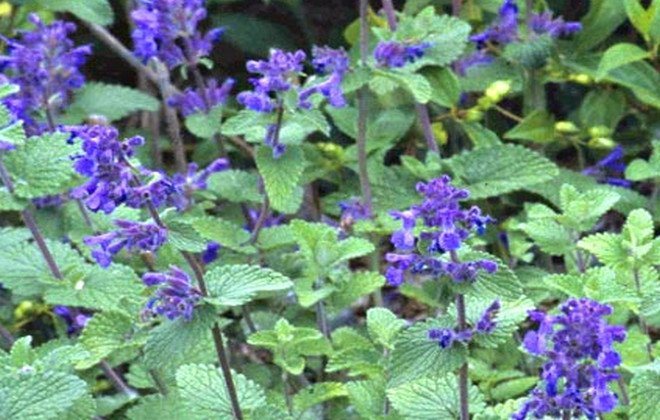

Walkers Low
Variety "Walkers Low" - a perennial spicy-aromatic plant up to 60 cm high with fine-toothed leaves and lavender-blue flowers. Flowering occurs twice a year: in May - June and September.
Prefers sunny locations and moderately moist soils. Frost-resistant, does not require shelter for the winter. Roses, delphiniums, phloxes, and silvery wormwood will be good neighbors in the flowerbed.
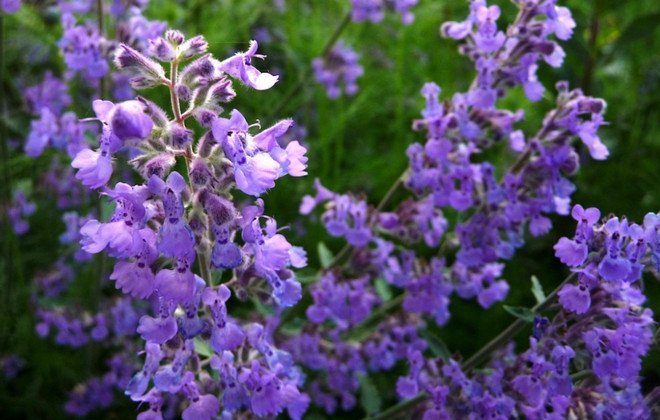

Important! Fassen's Catnip has a strong scent that repels mice and other garden pests.
Basic care
- Watering should be done moderately and only in the absence of rain for a long time, 2-3 times a month will be enough for the plant. Excess moisture is unacceptable.
- Mineral fertilizing is recommended annually in the spring, and organic (for example, bird droppings or mullein) - in the fall.
- Mulching with peat or humus will relieve you of constant weeding and loosening.
- Shelter for the winter period will only be required for young catnip plantations. Fallen leaves or spruce branches can be used.
- Possible pests - cicadas, disease - powdery mildew.
×
My Family Garden - Help
Dear friends!
In such a large assortment of all kinds of goods, it is very easy to get lost and of course you want so much! But it happens that there is no way to order everything at once.
So that you do not lose your favorite products and do not waste time looking for them, we have created a convenient section for you where you can save the items you like.
Now you can create your own personal "Family Garden".
On the page of our new section, you have the opportunity to create lists, convenient for you, where your plans for future plantings will be stored. Sort products into lists by price, culture, pick-up time, any property you like.
Did you like something but want to order it later? Create a list, save the selected items there and when the time comes, click the "all items in the cart" button. The total amount of the future order will be shown in the lower right corner.
To get started, use the already created "Favorites" list, save all the positions you like to it. If you want to create a list with your own name, just click the "Add new list" button. Give it any name that will help you navigate, for example "Seeds for 2019", "My Club", "Summer Flowerbed", etc. And when the hour comes, in a few clicks order all the goods you need, for example, for your winter garden.
Now looking through the detailed description of the product, you can click the "Add to My Family Garden" button, and the product you like will be saved in the folder of your choice.
Easy, fast, convenient! Happy shopping!
How to use the My Family Garden section
To add a product to My Family Garden, you need to go to the product page.
In the additional window that appears, select the list to which you would like to add the current product. You can select New List by giving it a name. After selecting the list, you must follow the link "Ok".
My Family Garden On the section page you can view all the products you have added, as well as the created lists.
From here you can add a product to your shopping cart, individually:
And also the whole list:
You can also remove an item from the selected list:
Or clear the entire list of products:
To completely remove the list, use the following link:


Create lists on a variety of topics. Examples of names can be very different: "My future summer flower bed", "For a summer residence", "Apple garden" and many others.Do you know exactly what you will order from fruit and berry seedlings? So name the list "Delicious", adding your favorite varieties there. And when the time is right, order the entire list in just a few steps.
We have done everything to make My Family Garden as convenient and intuitive to use as possible!
Catnip (Nepeta cataria) is a perennial herb of the Lamb family (Lipocytes), growing in the form of a bush. This aromatic herb has a place of honor in horticulture. Originally from the Mediterranean, from where it has spread throughout the world, and is not afraid of either heat or cold. In addition to the official name, it has many folk: catnip, lemon catnip, kitty cat, cat drink, forest nettle. As a medicinal plant, it is called a sorokaneduzhnik, as a culinary plant, it is called a shandra.
Why catnip?
The cattleman exudes a pleasant lemon scent, adored by absolutely all felines: from domestic cats to tigers, lions. Since ancient times, hunters have put catnip into traps to lure large felines. During the trip, put a sprig of catnip in the cage with your mustachioed traveler - the animal will be calm and will tolerate the trip better. What is the reason for such a craving of cats for this plant remains a mystery, because if you give a sniff of an ordinary lemon, the animal will not react in any way, and the scent of lemon mint beckons them.
The ancient Egyptians revered cats as sacred animals. They laid the catnip at the foot of the statue of the goddess Bastet, who was always depicted as a girl with a cat's head.
In terms of structure, the catnip is similar to lemon balm, so they are often confused. The color of the leaves of the catnip is rich green, in lemon balm - gray-silver, dusty. They also differ in the intensity of the aroma. To feel the lemon scent of catnip, you should rub its leaves in your hands, while lemon balm leaves are enough to touch on the bush, and it will tell about its origin. Melissa smells more intense.
In addition, a young catnip bush has a rose-tinged geranium aroma, and during flowering, it necessarily exudes a lemon scent. This is due to the presence of essential oils, the composition of which changes.
The height of the plant depends on the degree of illumination of the area. In the shade, the catnip stretches up to 1 m in height, and under the sun it grows more in breadth, limiting itself to a height of 40 cm. The leaves are medium-sized, with jagged edges.
During flowering, small flowers bloom, a characteristic shape for the Lipoids. Their color is not catchy: from whitish to pale lilac.
The seeds are very small, 0.5 g weight contains more than 100 seeds.
Application
Fassen's cattle is a favorite of gardeners, but it is widely used not only in landscape design, but also in cooking, folk medicine, aromatherapy, and the perfume industry.
In medicine
Due to its rich chemical composition, catnip has a positive effect on human health and has been used as a medicine for a long time.
The plant is known for its anti-inflammatory, antipyretic, hemostatic, expectorant, antidepressant, antispasmodic and tonic effect.
Anti-inflammatory and antipyretic effects are possessed by silvery elk, linden, cornflower, maple, white willow bark, wild rose, red elderberry, dogwood.
Decoctions and tinctures are made from it.
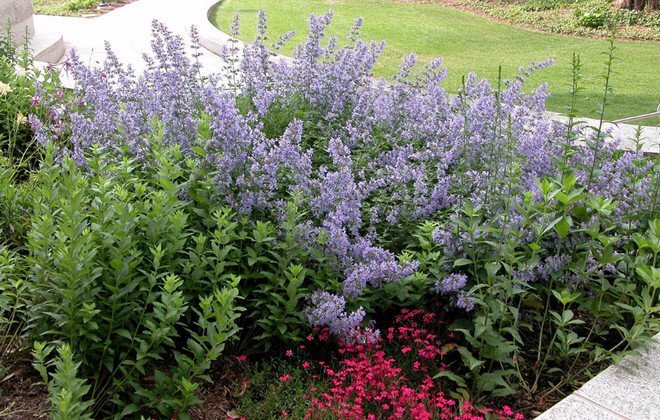

In folk medicine, they are used to increase appetite and improve the functions of the digestive, genitourinary, nervous, and cardiovascular systems.
The plant is effectively used for:
- cough;
- bronchitis;
- jaundice;
- gastritis;
- anemia;
- migraine;
- insomnia;
- kidney disease;
- Bladder.
Catnip-based preparations eliminate cramps, relieve spasms, reduce pain, relieve worms, and restore the menstrual cycle. The herb is often used in complex therapy for diabetes and hypertension.
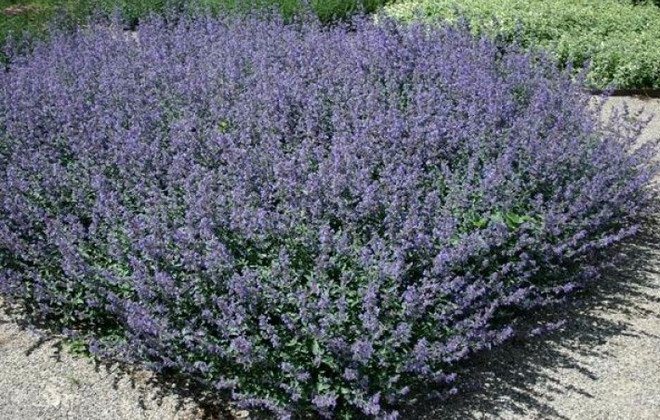

Catnip helps to increase immunity and normalizes metabolism in the body. Outwardly, this plant acts as an antiseptic for scabies, eczema, acne, boils and other purulent inflammations of the skin.
Did you know? In the Middle Ages, catnip was used to terminate pregnancy.
In aromatherapy
Essential oils are made from catnip herb. A few drops of such oils soothe the nervous system, help a person calm down and refresh, gain new strength. Warm baths with essential oils relax, relieve fatigue and normalize sleep.
The plant is effectively used in love magic for love spells. It is believed that the scent of this herb is able to rekindle love or keep a companion.
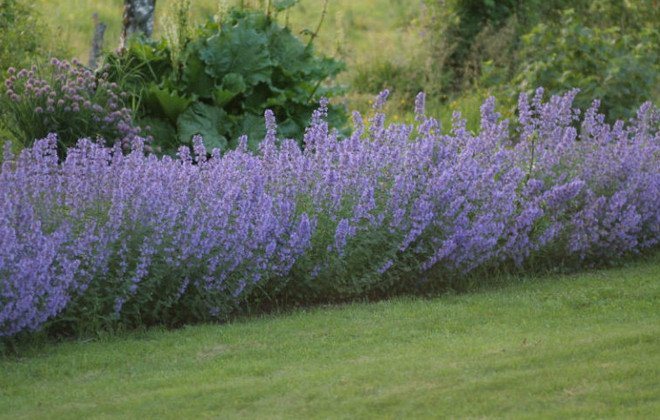

In production
Catnip essential oils are used for the manufacture of cosmetics for skin and hair care, as well as perfumes. Essential substances give them a fresh lemon scent.
In the manufacture of cosmetics, Veronica officinalis, amaranth, citronella essential oil, freesia, barberry, soapwort, and almonds are also used.
The plant is also used to make special toys for cats. It is often added to mosquito and cockroach repellents - a specific ethereal smell repels insects.
In landscape design
The catnip is distinguished by blue cold shades that are rare for plants and due to this it occupies an important place in landscape design. The plant is suitable for decorating flower beds, forms long flowering borders along the paths, goes well with stone in rockeries.
Roofs and facades are greened with miniature varieties. It will fit perfectly into any floral arrangement and will look magnificent and beautiful. Gardeners often combine it with roses, lavender, sage, phlox, peonies.
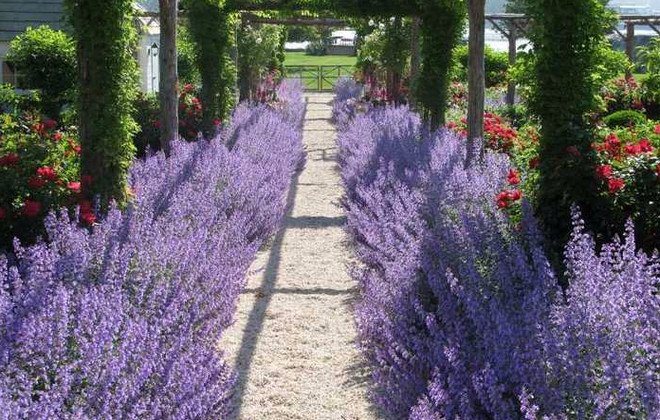

In cooking
Due to its rich lemon-mint flavor and pleasant spicy aroma, the plant is highly regarded in the cuisines of different countries. The stems and leaves are dried and ground into powder - a fragrant spice is obtained.
Cloves, saffron, nutmeg, turmeric, and chili are also used as spices.
It is added to marinades for salting fish, sauces, fresh vegetable salads, desserts, and jams. It is a wonderful ingredient for the production of cheeses, alcoholic and non-alcoholic beverages, confectionery.
Tea brewed from dried catnip is not only tasty, but also healthy, with a strong lemon scent.
Important! The catnip does not lose its useful properties and noble aroma after heat treatment.
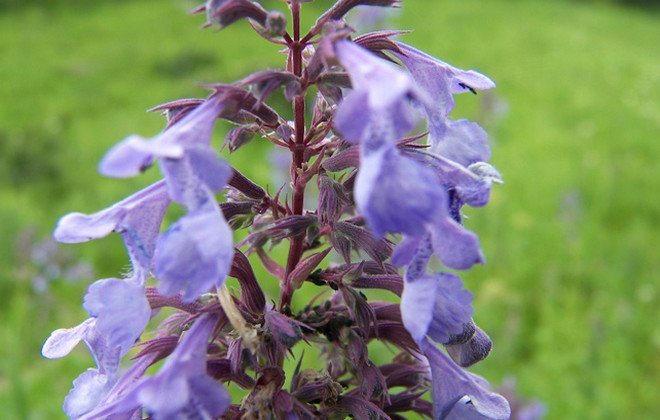

For what
Until now, not everyone knew what a catnip is, but even fewer people guess about its purpose. The Fassena catnip is grown for the following purposes:
- Medical. First of all, it should be said that the plant is able to increase heart rate by about 40%. An infusion of this herb helps to get rid of inflammation in the throat and normalize the gastrointestinal tract. For people with a weak nervous system and frequent depression, an infusion of catnip is shown. And finally, remember that it can be used to purify the blood.
- Edible. Freshly cut catnip leaves are used as a seasoning for salting and marinating fish. It is also an ideal addition to meat and poultry.
Today you have met such an amazing plant as the Fassena catnip. Growing a flower is simple, but you will get a lot of benefits. Only when using it is it worth adhering to some nuances.
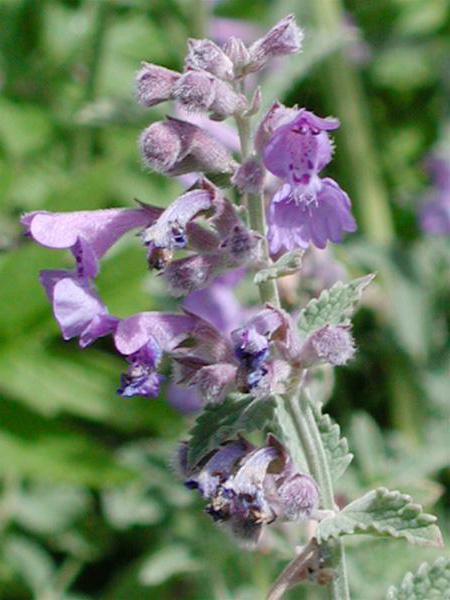

Growing a plant at home
Fassen's cattleman is famous for its unpretentiousness, but for its beautiful flowering, it is better to choose a sunny place and calcareous soil. The best places to grow catnip are areas where vegetables used to grow.
Planting seeds
For sowing seeds use:
- open ground;
- greenhouses.
The soil for growing catnip must be dug up and cleared of weeds. The garden should be well watered.Seeds are sown at the end of April in open ground in rows at a distance of 30 cm, no more than 1 cm deep.
The emergence of the first shoots begins 6-7 days after sowing. After the appearance of several true leaves, you need to make the first top dressing.
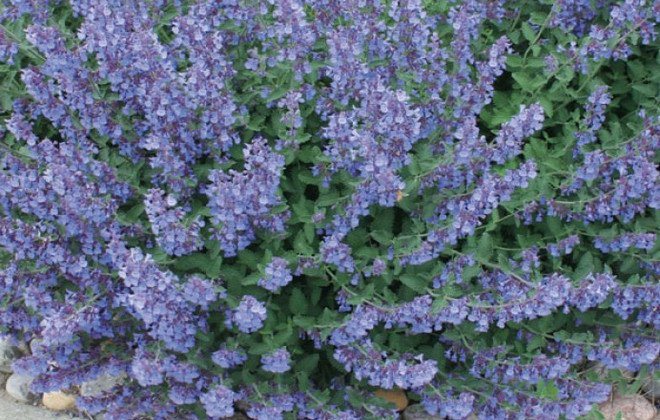

In greenhouses, seeds are sown for seedlings in the second half of March to a depth of 1 cm, in rows at a distance of 5-8 cm.
Seeds sprout slowly, 1-3 weeks. After the appearance of the first 2-3 pairs of leaves, the seedlings dive into small pots - this is necessary for the development of a strong root system. After 50 days, when three pairs of young leaves appear, the seedlings can be planted in the ground.
Important! If you plant catnip with seedlings, then you can wait for flowering in the first year. From the seeds, the results will be only for the next season.
Substrate and fertilizers
The cattleman is unpretentious to the soil and will grow in any corner of the personal plot, but still needs a certain feeding. In autumn, after flowering, 2-3 kilograms of compost or humus are introduced into the soil for each square meter, and in the spring they are fed with complex mineral fertilizer.
Complex mineral fertilizers include such as "Sudarushka", "AgroMaster", "Kemira", "BioMaster", "Crystalon", "Plantafol", "Azofoska".
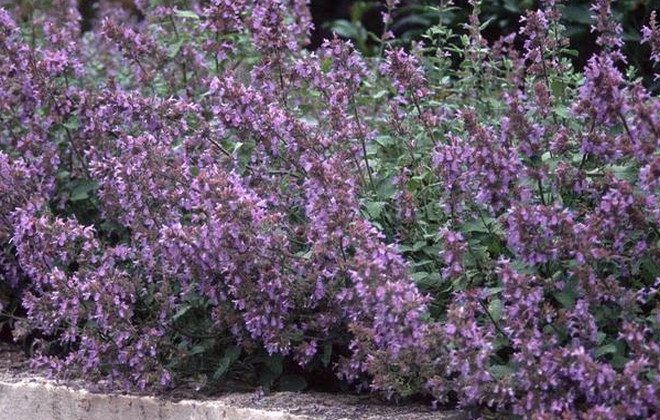

After each cut of the plant, the soil is fertilized with superphosphate and ammonium nitrate, 10 g each per square meter. The acidity of the soil should be slightly acidic or neutral. Acidic soil is usually deoxidized in autumn with dolomite flour during the introduction of humus.
Temperature regime
The catnip is intended for cultivation in the middle and southern lane. The ideal temperature for planting and plant development should be between + 16 ... + 21 ° C.
A plant planted in the sun blooms in the year of sowing, but will quickly fade and in the fall may die like an annual. In order for the plant to bloom for several years, it is better to plant it in partial shade.
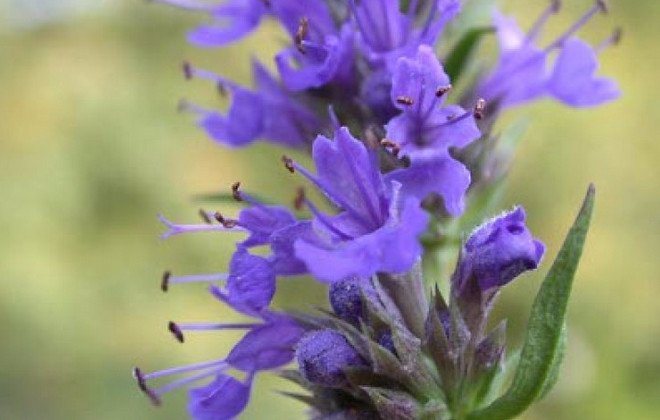

Care: moisture and watering
A perennial catnip can live for many years with proper care and watering. Many varieties are drought tolerant, but regular watering affects green foliage quality and flowering volume.
Watering the plant is necessary only when necessary, only after the soil dries out. Frequent and heavy watering will ruin the root system and the plant will die. Drainage is necessary to avoid excess moisture and stagnant water.
After each flowering, you need to trim the inflorescences in time to resume re-flowering. With good care, the plant grows quickly and will soon decorate the garden and fill it with a fragrant aroma.
Did you know? The catnip is an excellent honey plant. It is specially planted near apiaries. And experienced gardeners sow this plant next to greenhouses to attract many bees to pollinate vegetable crops.
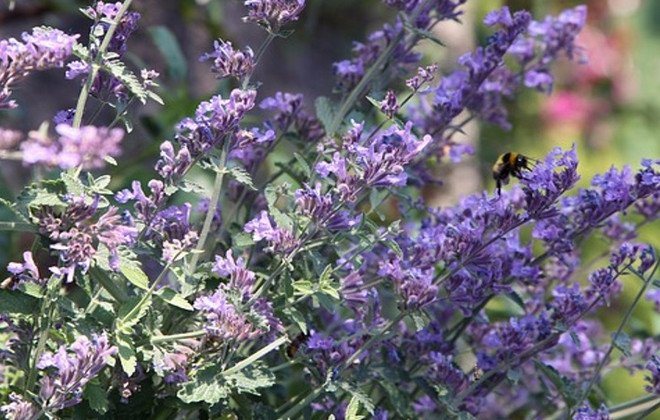

Landing
It is not difficult to grow a catnip, but you can face some difficulties. To make everything go well for you, you should use the following recommendations:
- Planting is done in soil fertilized with humus. If there is no manure, you can use complex fertilizers.
- Fassena cattle takes root on any soil.
- The place for the plant can be chosen sunny. A small partial shade is also suitable.
This plant takes root on any soil. Now it is worth paying attention to the question of how to properly preserve a flower for many years.
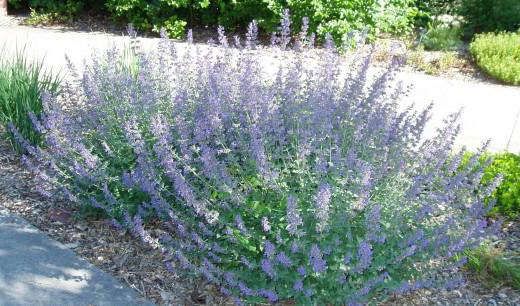

How does it work on cats
Almost every owner knows how catnip works on cats and why cats love this plant. Catnip oils contain the active substance nepetalactone. When it enters the nasal cavity, it irritates the olfactory receptors, easily penetrates the capillaries and, together with the systemic blood flow, reaches the brain.
Neurons also have specific receptors that receive a bioactive compound. When nepetalactone interacts with brain cells, animals develop short-term hallucinations.
Ethyl alcohol has a similar effect on humans. Mint-intoxicated cats often do unexplained things. The animal's behavior pattern changes dramatically, so it can become both aggressive and calm, regardless of its character.
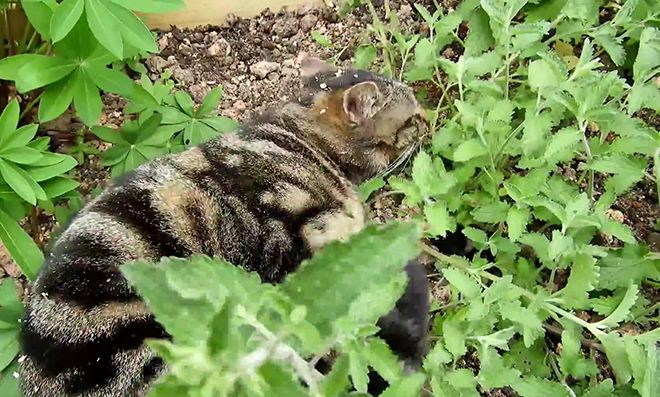

Often cats purr, roll on the floor, scream loudly, or actively lick themselves. Peppermint increases physical activity, so pets can jump high, climb up without any target, or run around rooms.
The effect from the plant is short-lived, because the amount of neurotransmitters in the cat's synapses is depleted after 10 minutes after inhaling the lemon scent. As a result, the pet's brain stops responding to the plant's oils. The level of neurotransmitters is replenished after 60-70 minutes, so after this period of time, the cat again begins to behave unnaturally.
Due to the high content of vitamins and microelements, catnip attracts animals. Cats eat the leaves, flowering shoots and stems of the plant for food. The animal can eat up to 100-150 g of mint, after which it stops.
Eating catnip - benefits and harms
It is well known that many indoor plants are poisonous and extremely dangerous for our pets: azalea, begonia, asparagus, dracaena, geranium, poinsettia, dieffenbachia, etc. Therefore, there are reasonable doubts: is it worth giving the pet catnip or it is better to do with the usual oats in a pot.
Veterinarians confirm that catnip is harmless to the health of the pet (unless, of course, you do not feed animals in large quantities with its extract or essential oil) and is not addictive. Moreover, sometimes it is recommended for easily excitable animals before travel, a visit to the clinic or a responsible event. For example, catnip extract, among other phytocomponents, is part of the most famous natural sedative for animals - Kota Bayun.


Bayun cat - sedative (sedative) phytopreparation for animals
Eating catnip can be harmful if the cat reacts strongly to it and becomes aggressive: some especially violent animals can growl, hiss, paws, throw off or drop a pot with a plant on the floor or on themselves. This must be taken into account before introducing the cat to a new exciting smell for her. Active use is not recommended for a pregnant female either, since an emotional outburst can negatively affect health. But as a rule, the short duration of the effect negates most of the side effects.
Disease and pest control
Catnip is a plant with excellent immunity, as well as high resistance to the "activity" of pests. And some can even scare away (for example, aphids or bedbugs). True, the delicate lemon scent of catnip can attract butterflies or aphids, which actively lay eggs on the plant, and the hatched larvae, in turn, are extremely dangerous for it. It is better to use natural remedies to combat the pest, since the chemicals can scare off pollinating bees.
As for diseases, we can safely talk about the almost absolute immunity of the plant to their effects. At least, experienced gardeners assure that if the agricultural technology of growing catnip is fully observed, the plant will not be afraid of any diseases.
Seed collection
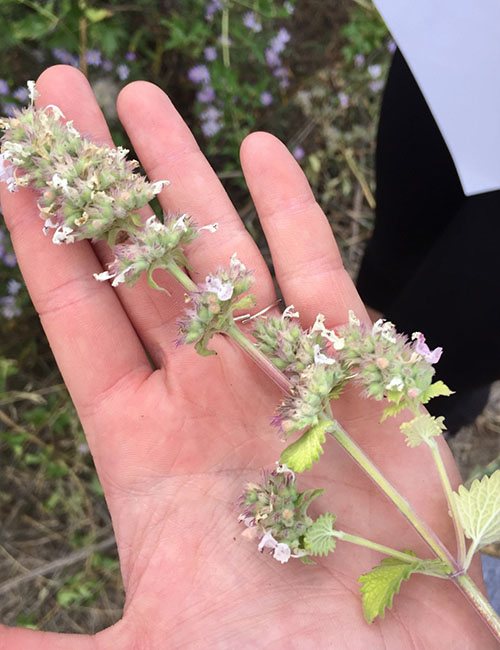

To get high-quality planting material, you need to cut the inflorescences in July or August. Grains should be started from the bottom buds. Inflorescences are cut off unripe. After separation from the bush, they are laid out on paper and kept in this state for several days.
You should take pure white paper for collecting seeds. Small dark grains may not be visible on the newspaper.
Once they are dry, you can begin to separate the grains. This is done by hand, after which it is folded into a sated and sieved.The unnecessary part remains at the top, and quality planting material passes through the holes.
Everyone can grow a catman on their site. To get a beautiful plant that can be used for food in the future, you will need to follow simple rules of care.
Blue carpet
Catnip The blue carpet creates a romantic atmosphere in the garden. His choose to create flower beds, rockeries, curbs, it can be grown in garden containers and pots.
This plant has a pleasant and rich aroma, combining notes of lemon, rose, geranium, lavender and lemon.
It is customary to grow blue carpet seedling, only in the southern strip it can be planted immediately in open ground. In order for the plant to grow safely and bloom profusely, a sunny place is chosen for it. Watering is moderate, if desired, you can use mineral fertilizers.
Catnip Blue carpet tolerates winter well, you do not need to cover it. The only exception is if the plant is sick and enters the winter period weakened. In this case, the soil is mulched and covered until winter.
Decorative wattle fence. An article and a photo about it here. And here is an article about decorative wood chips.
And in this section there is a lot of interesting information about the landscape.

